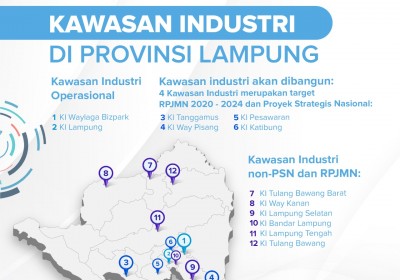Lampung’s Potential in Driving Industrial Growth
June 07, 2021
JAKARTA – The establishment of designated industrial zones (KPI) in a region is one of the instruments to help boost investment and drive economic development in the region. This fact is outlined in the Industry Ministry’s (Kemenperin) Ministerial Decree No. 30/2020 on Technical Criteria for Designated Industrial Zones.
“The rule states all the criteria that needs to be fulfilled, especially regarding the factors that need to be addressed when choosing a location to build the KPI and the role of the region’s government in developing the KPI,” Industry Minister Agus Gumiwang Kartasasmita said in a written statement on Thursday (29/4).
If the construction of industrial zones, small-scale industry (IKM) centres or individual industries are in line with the KPI rules, then the region’s business competitiveness will improve and will contribute to the government’s target to evenly distribute economic growth throughout Indonesia.
“The establishment of a KPI in a particular region should be followed up with efforts to accelerate development and fulfill the needs of the area’s industrial infrastructure and supporting infrastructure in the KPIs,” Minister Agus explained.
The Kemenperin’s director general for industrial access, security and zoning affairs (KPAII) Eko S.A. Cahyanto added that his department is currently advocating for the creation of a KPI in the Lampung province, which possesses great potential as an industrial sector development mover.
Based on data from Statistics Indonesia Lampung (BPS Lampung), the region’s processing industry is its second largest contributor to Lampung’s overall GDP in 2020, with 19.41%.
The Lampung province’s GDP experienced growth between 2016 and 2020, increasing by Rp 75.22 trillion or 26.92%. In the same period, the growth of its processing industry also experienced a significant growth of Rp 16.59 trillion or 31.75%.
“There are currently two operational industrial zones in Lampung province, which are the KI Waylaga Bizpark and KI Lampung. Also, there are plans to build 10 more industrial zones, four of them already included in the government’s Mid-Term Working Plan (RPJMN) for 2020-2024 and are considered strategic national projects,” Eko said.
The four industrial zones considered ‘strategic national projects’ are the KI Tanggamus, KI Way Pisang, KI Pesawaran and KI Katibung projects. The other six projects are KI Tulang Bawang Barat, KI Lampung Selatan, KI Bandar Lampung, KI Lampung Tengah and KI Tulang Bawang.
“With the issuance of the Kemenperin’s no. 30/2020 decree, this is the perfect moment to plan KPIs more thoroughly. Because of this, regions will be able to plan and design the construction of KPIs in their areas better to foster industrial development,” Eko added.
Lampung province is a strategic location due to it being located at the foot of Sumatra island. The construction of the Trans-Sumatra highway, which runs through Lampung, has shown the potential of further development in the province.
That is why the government hopes that greater industrial activity will help create more added value for the region. “However, we must also need to completely consider its uses in order to help attract investment into the area,” Eko said.
Related to the development of the industrial sector, regional governments are expected to also be able to integrate upstreaming and downstreaming processes for their leading commodities through the industrial zones.
“Aside from developing industrial zones, regions must also be able to develop IKM centres. This needs to be outlined in their industrial development plans and must be in line with their spatial planning,” he reiterated.
Indonesia’s Research Institutions Supporting the Development of the Electric Vehicle Industry
Indonesian Muslim Fashion and Cosmetics IKMs Shine at Dubai World Expo 2020
Govt Steps Up UMKM Transformation Efforts in the Midst of Pandemic Slowdown
Govt Encourages Promotion of IKM Products in Digital Era
Government Begins Developing Maritime Training Center in Makassar
Tweets by IDDevForum
